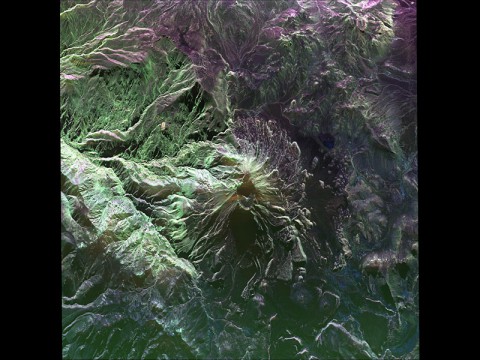Written by Alan Buis
NASA’s Jet Propulsion Laboratory
 Pasadena, CA – A NASA-developed airborne imager called a synthetic aperture radar took a detailed look at volcanoes in Central and South America during an Earth science study in late April and early May 2014.
Pasadena, CA – A NASA-developed airborne imager called a synthetic aperture radar took a detailed look at volcanoes in Central and South America during an Earth science study in late April and early May 2014.
The Uninhabited Aerial Vehicle Synthetic Aperture Radar, or UAVSAR, developed by NASA’s Jet Propulsion Laboratory in Pasadena, California, was flown on NASA’s C-20A. The 29-day deployment ended May 6th when the aircraft returned to its base in Palmdale, California, after 19 flights totaling 97 hours in the air.

“By combining images acquired in 2013 with the 2014 images, researchers will produce detailed surface motion measurements to improve volcanic deformation models,” said Naiara Pinto, JPL’s UAVSAR science coordinator.
NASA’s C-20A features a high-precision autopilot designed and developed by engineers at NASA’s Armstrong Flight Research Center, Edwards, California, allowing the aircraft to fly the same flight lines this spring as those flown in 2013 within 15 feet (4.5 meters) or closer. With the autopilot engaged, the synthetic aperture radar is able to acquire repeat-pass data that can measure land-surface changes within fractions of an inch (centimeters).
In coordination with the volcano studies, the agency’s C-20A gathered data over Amazonian forests in Peru, agricultural sites in Chile and glaciers on the Chilean/Argentinian border. All of these research projects involve Latin American institutions, including universities and hazard monitoring agencies.
More information on the mission is available here.
For more information on the UAVSAR, visit here.
NASA and its partners monitor Earth’s vital signs from land, air and space with a fleet of satellites and ambitious airborne and ground-based observation campaigns. NASA develops new ways to observe and study Earth’s interconnected natural systems with long-term data records and computer analysis tools to better see how our planet is changing.
The agency shares this unique knowledge with the global community and works with institutions in the United States and around the world that contribute to understanding and protecting our home planet.
To learn more about NASA’s Earth science activities in 2014, visit: www.nasa.gov/earthrightnow


